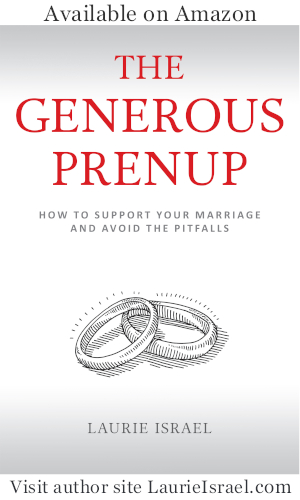By Laurie Israel
I’ve always thought of mediation as a process more akin to art than to science. Yes, there are important techniques that can be learned to create the possibility of a successful mediation.
But many things just seem to happen, if you let them flow without impeding them. There are three primary “scientific” mediation techniques that I see as most important. (1) exhibiting neutrality, and truly being neutral; (2) setting the stage to allow for an equal playing field so both parties can speak their mind truthfully; and (3) the mediator’s skill in intuiting the meaning behind the clients’ words.
But then there is the “art” of mediation. That’s the part that’s not taught in mediation training or learned by reading books, but has to be figured out and explored by the mediator as she or he gains experience in the practice.
There is a whole set of these “artful” techniques, that I’ve come to call “choreography” in mediation. They have to do with the timing of presenting and discussing issues that are to be decided by the clients, and also strategies to keep the temperature of the mediation at a safe
level. This cultivates an environment that help client make reasonable and sound decisions.
1. Taking baby steps.
Often in divorce mediation, there are major issues to be decided in which the “law” and practical solutions vary greatly. One of the most troubling one for clients is the issue of spousal support. It’s a “hot button” issue, and it’s often a glaring, beeping, siren of a hot button. It’s a
topic that can cause great agitation for clients, and therefore can pose challenges for a smooth mediation process.
And yet, spousal support must be decided (or at least considered) in a divorce mediation.
When I start a mediation, I don’t go right to the most difficult issues, such as spousal support, but rather I start with the easy ones. I call this technique “taking baby steps.” There will be plenty of these, so don’t worry about identifying them. And when I get to the difficult issues, I may set the stage for the discussion, and just let it begin, knowing that it is not likely to be resolved immediately in the first discussion, or even quickly thereafter in future sessions.
The parties will ponder the more difficult issues in between sessions after the discussion begins, and there is often significant movement in thought processes between sessions. Sometimes the clients will discuss an issue with each other in between sessions, which can be quite
helpful when the topic has been raised in a mediation session. Sometimes even a third or fourth mediation session on bits of the difficult problems are needed to further refine the discussion and come to resolutions.
So plant some seeds in that short first discussion. The seeds can be in the form of questions. It’s an indirect approach but seems to work quite well. For instance, one question that can lead to very fruitful results is this:
The mediator asks, “How do you intend to support yourselves after the divorce?” This is a very open question but leads to much useful reflection. People generally need time to ponder this major issue. By the next session, hopefully, thoughts will be clearer and emotions will be
more tranquil. That may be a good time for further discussion on the issue and make some progress.
2. Lead parties away from emotional and “hot” discussions.
We have all read the literature about how emotional stress prevents mediation clients from thinking rationally about the choices they need to make. Fear, anger, and anxiety can blight a mediation. They are the three horseman of the apocalypse that can prevent a successful mediation, to butcher (and co-opt) a Biblical reference.
The revelation here is that hot emotions can trigger physiological limbic system responses (here science enters the picture) that affect the brain. These center around emotions such as fear, anger and anxiety. The flooding of these emotions can cause a “fight or flight” response — a freezing response to perceived danger. This is bad for mediation, and in and of itself, can result in a failed session or a failed mediation. Even the memory of these emotional storms in just one session can derail the effectiveness of a mediation in future sessions.
I liken this to how a dog owner with a biting dog can handle their pet. Someone rings your doorbell, you open it, and your dog is right behind you. The person at the door might be a friend, or a delivery person. He reaches out to say “hello” to the dog, and the dog, fearful that
he is being attacked, bites the hand of the intruder.
Far be it from me to liken our mediation clients to unruly dogs, and yet… So what is a mediator to do to solve these emotional storms during sessions?
The technique is one you can actually learn from a dog trainer. It’s like a dance. Divert, divert, divert. Turn left quickly. Change the topic either totally, or partially. If the “hot” emotions continue, call them out, and let the clients know that we all need to leave that topic
in the current session, and why.
Give the clients a “treat” so that they divert. Move them on to something they like to discuss. Or tell them how well they’re doing (if truthful) about other aspects of the mediation and the decisions they have already made. That can be the equivalent of giving them a bully
stick or a nice piece of dried fish. Bully sticks and other rewards are good in mediation.
3. Leave a lot of space for silence.
When the mediation goes silent, don’t try immediately to step into those silent spaces and fill them. It’s a temptation we all have as mediators (and just as we do as people in conversation with other people, in general). The clients are thinking, and you can bet that one
(or both) of them will come into the silence and say something if you don’t say anything.
That something said in the silence may be very important, and may move the mediation along in a powerful way that helps flesh out the terms of the divorce.
Consider these silences as valuable. If you stay with it, you have a chance of encountering that “magical moment” in mediation, where the pieces of the puzzle start coming together for the clients. One of them may give something up in the spirit of generosity. These magical moments are more likely to happen if you give your clients space.
4. Don’t jump into what “the law” says, but let it be a background template for your questions.
Mediators have varying opinions about how important “black letter law” is to the mediation process. Some mediators start with what the clients want or think, without informing them of what settled law (or gray areas of law) consist of. (A few mediators even might even
forego providing information as to what other people have done when faced with identical issues.)
The opposite view is that “the law” is very important, and clients should make all decisions after being informed by what the law says on the topics they are deciding.
As a mediator, I do think “the law” is very important to mediation and the decisions our clients are making. They do need to make informed decisions about their future. By using “the law,” we can give our clients the benefit of years of court cases and legislative decisions. These
embody resolutions of the real experiences and needs of real people. Your experience as a mediator or lawyer is also an important source of knowledge for your clients.
Why should we assume that our divorce clients know what’s even possible for them as they plan for their future? But what is most important in the choreography of the mediation is the staging of the discussion. That’s where the choreography comes in.
My practice is to guide the mediation towards a discussion of the issues, by using clarifying questions (posed by the mediator) that can guide the clients toward at least considering the results that others (clients, courts, legislative bodies) have reached through experience.
Say, for instance, the issue arises as to how to treat premarital or inherited property in a divorce mediation. Most jurisdictions (even some of those that identify such property as “separate property”) tend to take an equitable view of such property.
Has the property been used to support the family, so that it is “woven into the fabric” of the marriage? Is property division of this potentially “separate” nonmarital asset, at least to some extent, needed to make sure one of the spouses will not be financially compromised after
the divorce? What is an equitable solution if one of the spouses previously blended this type of “separate” asset into marital property to pay household and living expenses, but the other spouse may receive a future inheritance? What is fair?
That’s the type of discussion that’s needed. You don’t have to pound “the law” into the clients’ faces. You can raise legal issues indirectly, and in this way set the stage for informed decision-making.
5. Try to help clients visualize their situation as a puzzle to be solved.
As alluded to earlier, emotions can derail a mediation. What type of choreography is needed to redirect the parties away from an emotional state in which they rehash their grievances?
One of the major dance steps turns out to be nudging the parties towards rationality. In the beginning of most mediations, I must admit, I myself experience some apprehension and anxiety about the unknown, and so do the clients. Will there actually be a solution for some of the tough issues that they need to decide? The unknown causes anxiety.
Sometimes, resolution of a particular problems at the beginning of a mediation seems to be unattainable and causes fear in the process.
But rest assured, there are always solutions to the puzzles that need to be resolved (at least most of the time). The clients often come to these solutions themselves with effective mediation. Sometimes they do so by expressions of generosity that are unforced and unpredictable that might grow as the mediation proceeds.
Part of the choreography here is to not jump to solutions. That’s a good rule, both for the mediator and the mediation clients. Jumping to solutions leads to short-circuiting the process and unsound decision making. Premature solutions can lead to half-baked decisions
and inferior solutions.
Hold back on finalizing a decision the clients may have put forth, even when it seems to be the “right” one. Remember, a global settlement of all issues is needed for the package of decisions to work together and resolve your clients’ situation and result in a completed mediation.
Conclusion.
Following these five strategies, and including them in the choreography of your mediation, can help your clients achieve a successful mediation. And success can be defined by sound and rational decisions made by the clients that feel fair and equitable to each of them.
In this way, we can be most effective in helping our mediation clients navigate the unknown future.
© 2021 Laurie Israel. Published in mediate.com, May 12, 2021.
- Mediation – A Sound First Step to a Successful Prenup - September 27, 2022
- The Art of the Term Sheet - May 18, 2022
- Learning from Every Mediation - August 4, 2021

